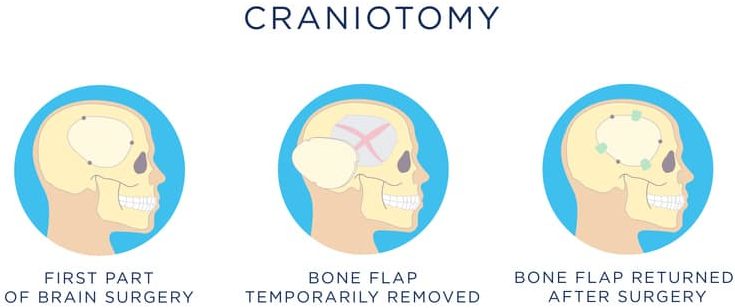What is a Craniotomy?
A craniotomy is a surgical procedure in which part of the skull is removed in order to view the brain. The piece of skull removed is called a “bone flap.” After the necessary brain surgery is performed, the bone flap is fitted back into the skull. Craniotomies are designated in different ways. A frontotemporal, parietal, temporal or suboccipital craniotomy is named after the bone that is removed. The minimally invasive “keyhole” craniotomy, on the other hand, is named after the small dime-sized incision that is made in the skull.
Why are Craniotomies performed?
Craniotomies, which are performed by neurosurgeons, are appropriate in a number of situations, including for:
- Diagnosing/removing/treating brain tumors, including meningiomas
- Removing blood or blood clots, including subdural hematomas
- Repairing tears in the membrane that lines the brain
- Repairing or clipping aneurysms
- Draining brain abscesses
- Removing arteriovenous malformations (AVMs)
- Repairing skull fractures
- Repairing tears in the membrane lining the brain
- Treating epilepsy
- Implanting stimulator devices to treat movement disorders
Craniotomies are also used to relieve pressure within the brain caused by traumatic injury or stroke.
The Craniotomy Procedure
A craniotomy is performed, sometimes under general anesthesia, in a hospital. An incision is made in the scalp (which is shaved at the incision site), and the bone flap is removed to allow access to the treatment area. There are cases in which patients remain awake during surgery, and are asked to move their legs, recite the alphabet or tell stories to ascertain whether brain functioning has been affected. Location of the incision will depend upon the area being treated. A medical drill may be used to create small holes (as in keyhole craniotomy), or a special saw may be used to cut the bone flap. Once the procedure is complete, any tissue that has been cut into is stitched together, and the bone flap is reattached using plates, sutures or wires.
How long does a Craniotomy Procedure take?
The time required for these procedures varies widely depending upon the size and location of the tumor, along with the types of symptoms the patient had prior to surgery.

How long does it take to recover after an Awake Craniotomy?
After your surgery, we may request an MRI to ensure that the removal of the tumor was complete. You’ll be in intensive care for a while immediately following your craniotomy, and you’ll have 2-3 days in the hospital.
There isn’t much, if any, real physical pain. Your incision or incisions will be sore for about 5 days after your surgery. You will probably feel very tired for several weeks after this procedure. You may also have headaches or problems concentrating.
Most patients can return to work and normal activities in anywhere from 6 to 12 weeks.
Additional Frequently Asked Questions about the Craniotomy Procedure
Brain tissue doesn’t have any pain fibers, so you can’t feel any pain when we’re removing the tumor or correcting the issue involved. You may have a feeling of pressure or vibration during the surgery, but this isn’t pain. We use local anesthetic to numb the muscles, skin, and bone that we have to cut through to access your brain.
Every patient is unique in his or her situation, so it’s impossible to make generalities about these brain surgeries. But most patients are able to fully recover with few if any complications, and this surgery allows them to continue with their daily life. In cases of a brain injury or stroke, craniotomies can save the patient’s life by preventing damage caused by bleeding or swelling in their brain.
Your Texas Neurosurgery surgeon will give you the green light to drive. This can vary, but most patients can plan on being able to drive after 2 to 3 weeks.
There isn’t a set timeframe for returning to work. As mentioned, it’s not about pain, but the feeling of fatigue and problems with concentration and focus. The shortest return to work would be from 4 to 6 weeks, but you could take much longer than that. There’s no way to predict.
Prior to your surgery you will meet with your Texas Neurosurgery surgeon and your neuroanesthesiologist. We’ll explain the entire procedure from start to finish. We’ll detail what you can expect during your recovery. During this time, we want to get to know you and find out areas of life that are important to you. This allows us to personalize your neurological exam, allowing us to talk to you about things you care about during your surgery. This helps you stay awake and actively participate in the mapping process longer.
We may have you identify pictures and words on cards or on a computer so that your answers can be compared during surgery.
We want you to ask any and all questions you have because we want you to be all in on this process. That creates the best possible outcome.

Have more questions? Schedule a Consultation
To learn more about craniotomies, please call our office today to schedule an appointment. With locations in Dallas, TX the providers at Texas Neurosurgery are proud to service patients in Dallas, Plano, Richardson, and nearby areas.

